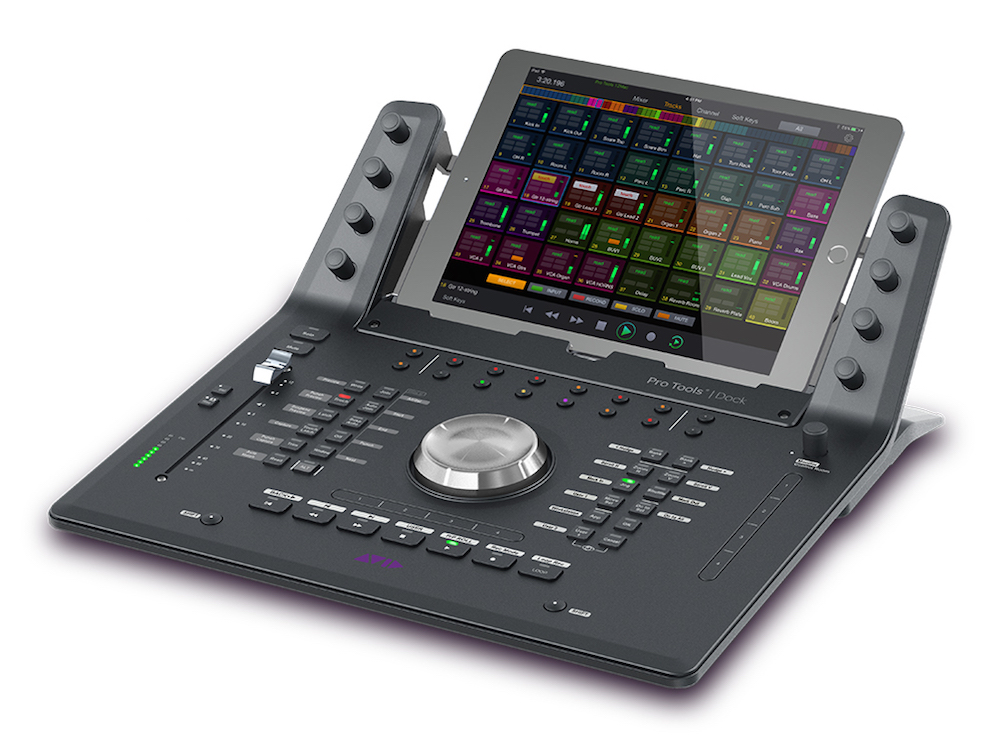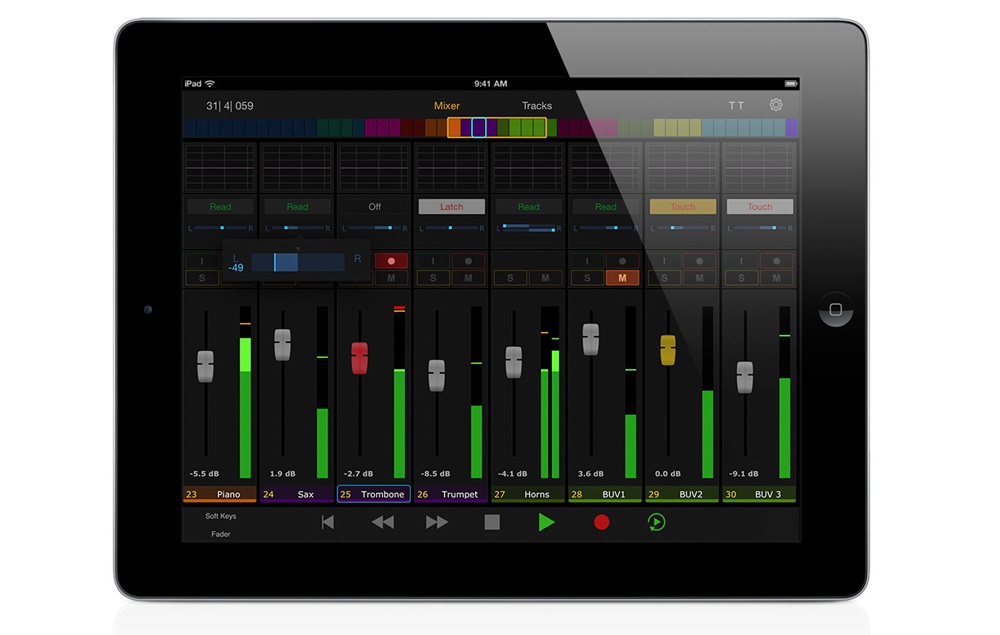New Gear Review: Avid’s Pro Tools Dock
When it comes to mixing in the studio, a majority of audio engineers—whether in music or in film—work “in the box” these days.
While the technology for mixing films and albums has largely shrunk to the size of a desktop computer, one sector of the pro audio marketplace has been surprisingly under-represented:
Hardware control.
That is to say, the fader, the transport and all of the tactile hardware that helps us connect physically with our plugins and our mixes.
The marketplace for hardware control of DAWs is unbalanced between ultra-basic cost effective products and incredibly complex, full scale digital mixing consoles costing tens of thousands of dollars. Avid is looking to change all of that with the new Pro Tools Dock. Let’s take a look at what Pro Tools Dock has to offer:
Features
Avid Pro Tools Dock is compatible with OS X 10.10.5+ and Windows 8 or 10. The unit runs natively on Pro Tools 12.5+ as well as Apple Logic Pro X, Cubase 8.5+ and Nuendo 7+, and retails for $1199 USD.
So, what is the Avid Pro Tools Dock all about? Control! Avid has created a desktop single fader control surface which looks and feels like a mini version of their flagship S6 controller.
The hardware dock itself communicates simultaneously with Pro Tools as well as the Avid Pro Tools | Control app for iOS via iPad, which sits at the top of the Pro Tools Dock (iPad not included).
The Avid Pro Tools Dock sports a single touch-sensitive motorized fader along with full transport controls—true essentials for anyone seeking a hands-on workflow in the digital domain.
The main aesthetic focal point of the unit is a large, fully programmable Jog/Shuttle wheel, which is situated just below sixteen programmable color coded soft keys. There are also two programmable touch strips, one of which is oriented vertically while the other horizontal.
On either side of where the iPad is set, you can find eight push-top touch sensitive soft knobs. All of these features integrate seamlessly into the iOS Pro Tools | Control app.
Unboxing and Installation
Pro Tools Dock is impressive in its design and layout. Right out of the box, Pro Tools Dock looks and feels like a real console in a small footprint. The controls are laid out in such a way that is easily understandable at first glance. The connections on the back are as simple as possible: Power, Ethernet, ¼” footswitch and USB power for the iPad.
Installation is a simple process in Pro Tools and I was up and running in just a few minutes. The hardware dock connects with Pro Tools via the EUCON Control app over an Ethernet connection while the iOS Control app connects via WiFi to your computer.
All of the unit’s features and workflow possibilities felt a bit overwhelming at first. However, the basic controls are simple and easily accessible, allowing you to begin working immediately, learning as you go.
In Use
The Avid Pro Tools dock packs a staggering amount of control for your DAW into a very compact footprint. The dock itself is essentially the center section of an S6 console which utilizes an iPad as the visual touch screen. This is an incredibly smart way to keep costs down while providing you with software that is easily updatable as the Dock and your DAW evolve.
I test drove the Avid Pro Tools Dock on two feature films, Bwoy and Do you Take This Man, both starring Anthony Rapp. I also wrapped up mixes for the debut album by House of Hamill from Philadelphia. The Pro Tools Dock was also used on episodes of podcasts I mixed including Here’s The Thing with Alec Baldwin for WNYC and The West Wing Weekly.
Working in Pro Tools for post-production means using clip gain a lot. I am constantly adjusting clip gain during editing and mixing of TV and Film projects, so I was excited when I learned that nearly every button and knob (including the aluminum weighted jog/shuttle wheel) is assignable on the Pro Tools Dock.
It did take me several minutes and a few trips back and forth from the manual to learn how to program it, but eventually I was able to assign one of the Dock’s function buttons to act as an on/off switch for shuttle wheel clip gain control. This allowed me to use the shuttle wheel to adjust the clip gain of any selected clip in my Pro Tools session. This is an invaluable feature, and one that I wish was pre-assigned on the Dock, as it was in constant use during my test drive.
The most crucial feature of any DAW controller for me is the quality of the fader itself. Avid Pro Tools Dock features a touch-sensitive motorized fader that feels great and works flawlessly. Since the Dock itself is truly a mini S6 console, it was no surprise to me that the fader itself felt incredibly solid and performed well.
It would be fair to say that even after spending a full two weeks with the Pro Tools Dock, I feel as if I barely scratched the surface of what this unit is capable of. Considering that almost every button and knob on Pro Tools Dock is customizable via EUCON software, it’s clear that Avid is committed to making the Pro Tools Dock as user-friendly as possible. If you take the time to really learn and customize this unit to your own particular workflow, there is a great deal of functionality available at your fingertips.
iOS Pro Tools | Control
The heart of the Avid Pro Tools Dock is the iOS Pro Tools | Control app. Control works seamlessly with your Pro Tools Dock, providing visual and touch controls for a myriad of Pro Tools features such as pan, volume, mute, solo, edit and mix view, as well as control over plugins.
One of my favorite uses for the Control app is using the Dock’s push-top, touch-sensitive knobs to adjust EQs, compressors and other plugins in my mix. Using actual hardware knobs to adjust my mix tracks brought back an almost nostalgic feeling of being in a studio, having that physical contact with my mixes. On most plugins, the Pro Tools Dock knobs allow you to zero out your setting with a simple push on the knob which is a great way to experiment with a sound and get back to zero with maximum efficiency.
The visuals are laid out sensibly in the Control app, allowing you to navigate around each control on a plugin quickly and efficiently. One notable feature that is currently missing in iOS Control is gain reduction metering. Since the Control app displays the controls for a compressor but not the gain reduction itself, I have no way of keeping my eyes focused squarely on the Pro Tools Dock while adjusting my compressor to know how much gain reduction I’m applying. This is surprising as Pro Tools HD provides visual gain reduction metering on its track layout.
In my discussions with Avid, it seems like this is potentially a forthcoming software update to iOS Control. Overall, iOS Pro Tools | Control is a smart and intuitive app that is perfectly married to the Pro Tools Dock.
To Be Critical
The Pro Tools Dock performed unquestionably well under many different mixing circumstances. Along the way however, I did find a few things that caught my attention as problematic.
Although the LED level meter with clip light is a great feature of the Dock, the placement of the meter felt like a bit of an afterthought as it is completely covered by your hand while using the fader. This seemed like a slightly confusing choice to me, as it seems there is plenty of available space on the adjacent side of the dock, where the meter would remain visible at all times.
The Monitor Control knob is useful, but left out an important feature I would love to see. When I first saw images of the Avid Pro Tools Dock online, I was excited by the monitor control knob as I was really hoping that the Pro Tools Dock would feature passive analog monitor control. For my setup, this would effectively replace both my current fader and my volume control box. I was a little disappointed to find that the monitor/control room knob is a software control only knob for applications that support this EUCON feature, such as the XMON App, Cubase, and Nuendo.
This struck me as a curious choice, and almost deceptive feature to me as this feature is essentially unusable in my system. I would be even more inclined to integrate the Pro Tools Dock into my permanent setup if a future version of the Dock included passive monitor control, perhaps via multi-pin to XLR breakout connector. At the current price point of $1199, I would gladly pay a bit more on the base price of the unit for integrated passive monitor control.
Summing it Up
For what it does, the Avid Pro Tools Dock is by far the best marriage of features, price and functionality on the market. Nearly every engineer I showed this product to expected the price point to be well over $3,000. But at just $1199, Avid has created a product that offers professional level features at a price point that is accessible to everyone.
For me, owning an iPad already meant I was halfway home with Pro Tools Dock. While there is certainly room to improve in both software and hardware on the Pro Tools Dock, Avid has created by far the best single fader control surface in a small footprint available on the market today.
Zach McNees is a Brooklyn-based producer/engineer/mixer and live recordist whose work includes Björk, Rob Thomas, The Gregory Brothers, Pixies, and many more. Zach’s post-production work includes House Hunters International (HGTV), VICE (HBO), All-American Makers (Science Channel) and the award winning documentary short “For The Love of Dogs”. Get in touch with Zach at http://www.zachmcnees.com.
Please note: When you buy products through links on this page, we may earn an affiliate commission.








